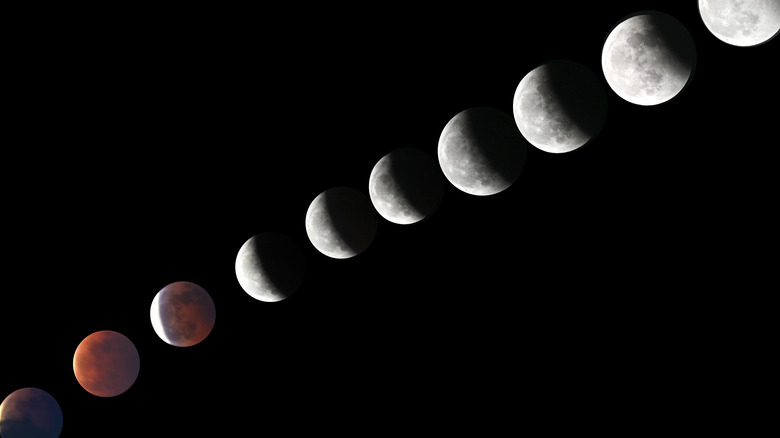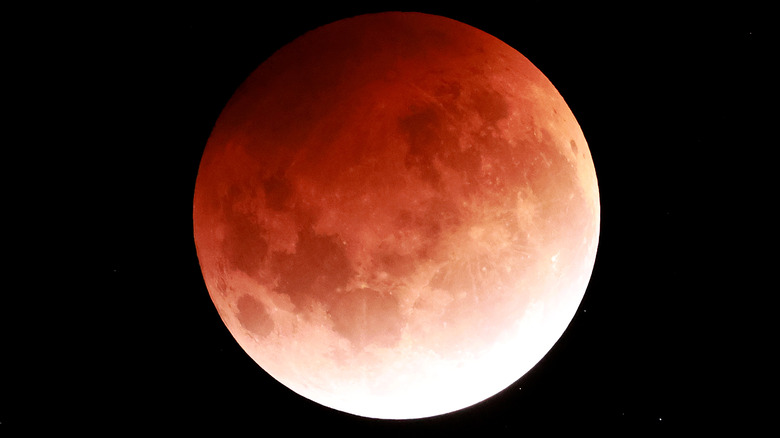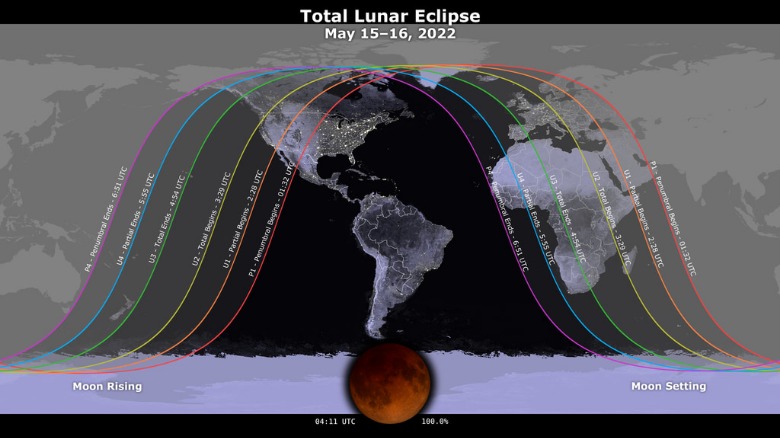Here's How To See This Week's Blood Moon
If you like to look up at the sky and let that sense of wonder wash over you every now and then, this week is the best time to do so. Why? Because there's a lunar eclipse about to happen, and it's going to be extra special this year. You'll be able to see the lunar eclipse for yourself if you look at the sky on the night between Sunday and Monday — that is, on May 15 and May 16. While it will be visible to some extent in most parts of the globe, you won't be able to see it from everywhere. Let's take a look at all the best ways to watch the so-called "Blood Moon" this week.
"Blood Moon" is a common term for the eclipsed moon because our local satellite often turns some shade of red during the eclipse, ranging from copper to much darker colors. When the eclipse falls in May, that name is sometimes expanded to "Flower Blood Moon" or just "Flower Moon." This flowery — pun unabashedly intended — name was given to the May eclipse because in many parts of the globe, including North America, May equals spring, and that brings countless flowers in full bloom.
The evocative name pales in comparison to actually watching the lunar eclipse. While solar eclipses are few and far apart in comparison, we can observe the blood moon much more often, but that's no reason to skip out on this one — as mentioned above, it could be one of a kind.
This lunar eclipse may be one of a kind
What's so special about this year's eclipse? To explain that, we have to note that the color and visibility of the moon are heavily impacted by the clarity of the Earth's atmosphere. This means things that happen down on the ground can affect how the lunar eclipse is going to look. According to Helio Vital, the moon's visibility may be altered by the Tonga submarine volcano eruption that climaxed in January 2022. Even months later, the aerosols that it produced are still present in the upper atmosphere.
As a result of the volcano eruption, Helio Vital predicts that this year's lunar eclipse may be especially dark. Sky & Telescope shared a handy image of the various shades of a blood moon, and if the predictions check out, we may be looking at one of those darker shades — most probably number one in its illustration.
Whether it's going to be especially dark or not, the moon will undoubtedly look thrilling to just about anyone who cares to look at it. If you're not sure whether the visibility will be decent in your area, or you can't see yourself staying up to watch it, rest assured that there are plenty of ways to watch the lunar eclipse of May 2022.
How to watch the lunar eclipse?
You don't need a telescope or any other equipment to watch this week's blood moon — all you need is your own pair of eyes. However, depending on where you are in the world, you may see more or less of the eclipse. NASA has prepared a visibility map that shows where you'll be able to see it, and luckily, most of the globe will be able to catch at least a glimpse of the full show.
If you live in the U.S., the eclipse will begin around two hours after sunset on May 15, starting from the East Coast or an hour after sunset for the Midwest. On the West Coast, the moon will rise already fully eclipsed, which means that you won't be able to see much until the sun sets fully and you'll be able to spot the striking image of the eclipsed moon. Skywatchers from Europe and Africa will have to wait until the early morning hours on May 16 to spot the eclipsed moon.
If you can't watch the event in person, NASA is going to live stream the whole thing on its official website. The stream will begin on May 15 at 11 p.m. Eastern. TimeAndDate is also going to stream the event, starting a bit earlier at 7 p.m. And if you're excited about the next solar eclipse, mark the date in your calendar because the next such eclipse that will be visible in the United States is less than two years away.



